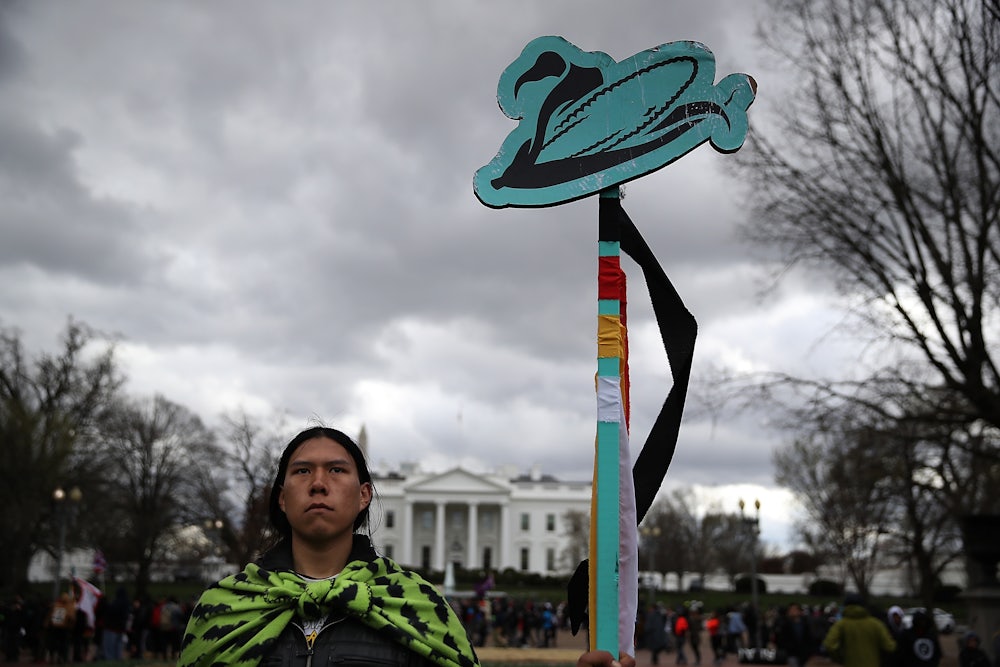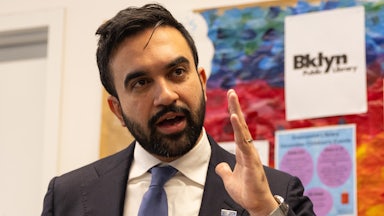President Joe Biden has a decision to make. Wednesday, February 10, marks the court-mandated deadline for the U.S. Army Corps of Engineers to declare its immediate plans for the Dakota Access Pipeline, which is currently operating without an updated environmental review. The fate of DAPL is being watched closely across Indian Country and beyond, just as it was five years ago, when tens of thousands of Native water protectors and non-Native allies convened at the Missouri and Cannonball Rivers in North Dakota to protest the incursion on Indigenous land and water rights.
This week could have served as the beginning of DAPL’s final chapter. After all, on his first day in office, Biden issued an executive order halting any further construction on the Keystone XL pipeline, overturning the 2017 executive order signed by President Trump, which had itself overturned the Obama administration’s initial decision to block the pipeline. Instead, those waiting for DAPL’s death may have to wait a bit longer.
The Corps is a military agency that, at Biden’s command, could conceivably use the court session to officially stop the flow of natural gas through DAPL until an extensive environmental review is completed. But on Monday, the Associated Press reported that the Corps filed for an extension with the court in hopes of delaying the decision until April. That the Corps—and by proxy, Biden—are looking to punt on the issue raises several concerns about the administration’s stated commitments to both Indian Country and a climate-friendly economy.
As reported by Bloomberg in late January, all signs point toward the Biden administration taking a hands-off approach on DAPL, opting instead to let the issue resolve itself in court. The reasons for this are fairly clear, per Bloomberg: Biden does not want to piss off labor unions, which have been clinging to the roughly 8,000 temporary jobs that DAPL will create. Brookings estimated in 2016 that just 40 permanent positions are expected to result from its operation.
There’s also the matter of optics and Biden’s Cabinet. As evidenced by the hearing for Michael Regan, Biden’s nominee for Environmental Protection Agency administrator, Republican lawmakers are dead set on framing any moves by the current administration to cut down on extractive infrastructure as a direct attack on the American economy and its workers. (Again, remember that these are temporary jobs we’re talking about.) Regan’s confirmation process is expected to proceed smoothly and end with him being seated as EPA secretary. This is thanks in large part to his reputation as a compromiser, having spent his time atop the North Carolina Department of Environmental Quality negotiating settlements for coal-ash cleanup with Duke Energy while also approving the company’s permits for its since-canceled Atlantic Coast Pipeline.
But Biden’s nominee for secretary of the interior, Congresswoman Deb Haaland, is facing a loud and growing conservative opposition effort. This is because Republican senators like Steve Daines of Montana see Haaland’s appointment as a threat to their long-standing ability to flip Native nations the bird and allow campaign donors to build, mine, and pipe to their hearts’ desire. Should the Biden administration cancel a second major pipeline before Haaland’s confirmation process begins, it stands to reason that Senate Republicans would use the forthcoming hearing to make a considerable fuss over the appointment of an elected official who just happens to be on track to become Interior’s first Native secretary.
These, then, are the political reasons to kick the can down the road. But they paper over a harsh truth: Every day that DAPL is allowed to continue pumping oil down the line, the cost can be measured in lives, not just Cabinet confirmations.
On Tuesday, a study published in Environmental Research, based on research from an international collective of universities, found that over eight million people died in 2018 from fossil fuel pollution—double the fatalities that had previously been estimated. That means that the pollutants from projects like DAPL were responsible for nearly one in five of the world’s deaths that year. Additionally, man camps, which house the temporary workers on such construction projects, have been directly linked to the murders and kidnappings of Indigenous women, an epidemic that has risen to crisis proportions in both Canada and the United States—so much so that even the Trump administration started a half-hearted campaign to address it.
Stopping a pipeline via the courts means subjecting the people at risk from these outcomes to a deadly waiting game. It entails retracing every update in the pipeline permitting process, checking to make sure both tribal consultation processes and environmental reviews were followed, and then—if the pipeline was approved despite the aforementioned shortcomings, as it was in the case of DAPL—hoping that the judge hearing the case believes in upholding tribal sovereignty and federal environmental policies.
Look at what’s been required to reach this point: When first announced, the pipeline faced resistance from a number of tribal nations along its path, most notably the Standing Rock Sioux Tribe. The Obama administration didn’t heed the opposition or adequately consult and obtain consent before approving large swaths of the construction, which led to the protests. The protests applied a great deal of pressure to the administration, as well as the presidential campaign of Hillary Clinton. Neither Obama nor Clinton clearly and strongly threw support behind the tribes. Finally, after the 2016 election, Obama used his lame-duck month to deny a permit that would have allowed the DAPL to cross the Missouri River. This was immediately undone by Trump, who also reauthorized the Keystone XL pipeline.
Since 2017, DAPL has been carrying oil from North Dakota to Illinois. The tribal nations took the case to court, claiming that a proper environmental review had not been completed. In January, the U.S. Court of Appeals for the District of Columbia Circuit confirmed a decision made by a lower court last summer, which pulled a crucial DAPL easement on the grounds that an environmental review had been rushed. Two weeks ago, the D.C. Circuit requested that the Corps provide an outline for its future plans regarding a crucial DAPL easement, bringing us back to today.
There is a bleak feeling of hopelessness in watching pipeline permits ping back and forth between presidencies as affected Native and other marginalized communities are relegated to the position of onlookers. But Biden’s move on Keystone, in addition to staving off the major natural gas project for at least three years, was by nature symbolic. Here was a president who, like Obama before him, made campaign promises to consult with tribal nations on domestic infrastructure projects that were charted to run through sovereign lands, and unlike Obama, Biden wasted no time in making a decision on Keystone.
As we approach the five-year anniversary of the Standing Rock protests in April, the same basic questions the protests raised have yet to be answered. Biden has the chance to follow through as he did with Keystone. There’s no good reason to wait for April.








